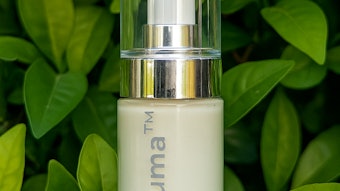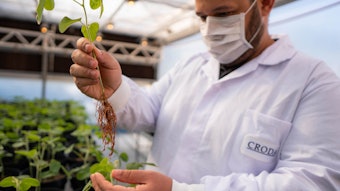Little Johnny watched, fascinated, as his mother smoothed cold cream on her face. “Why do you do that, mommy?” he asked. “To make myself beautiful,” said his mother, who then began removing cream with tissue.
“What’s the matter?” asked Johnny. “Giving up?”
An all-natural skin treatment formula with multiple benefits containing polyphenols and antioxidants, free of petrochemicals, fragrance, parabens and phthalates—it is certainly a cutting-edge product for today’s consumer. Incredibly it can be found in Galen of Pergamum’s ceratum refrigerans—cold cream—a 2,000-year-old blend, which proves that the more things change, the more they stay the same. Tracing the history of Galen’s cream through the millennia illuminates the way skin care evolved from crude concoctions to modern emulsion formulations.
Claudius Galenus (Galen of Pergamum A.D. 130–200), one of the greatest medical minds of antiquity, created the world’s first efficacious skin cream—ceratum refrigerans (“cooling wax”). It was made by mixing one part beeswax in three to four parts of olive oil and then adding as much rose water as possible. It wasn’t elegant and barely stayed together, but it was state-of-the-art skin care for more than a thousand years.
A Closer Look at the Ingredients
Galen’s formula contains another modern formulation positive: All the ingredients are good enough to eat. Beeswax isn’t exactly eaten, but it is food-grade and often used to coat cheese. Olive oil is a great staple in food preparation and is a key component of healthy diets—and rose water can be consumed for a variety of health benefits.
But it’s the complex chemistry of beeswax that made Galen’s cream effective. Beeswax contains approximately 300 compounds, and is not remotely like petroleum-based wax such as paraffin. The exact composition varies greatly from different sources, but all beeswax has a few things in common. And notably, for its use in a primitive formula such as Galen’s cream, it contains enough hydroxy groups to allow it to absorb some watery material.
Olive oil contains a rich brew of valuable components. The oil has vitamins A, E and K; phytosterols; the flavonoids luteolin, quercetin and squalene); and is rich in polyphenols—which are anti-inflammatory, antioxidant and anticoagulant. Then there is oleocanthal, a nonsteroidal anti-inflammatory and antioxidant, and squalene—which helps regulate sebum. Also present is chlorophyll, an anti-aging substance that promotes the healing of skin conditions and wounds.
Rose water is the by-product of the production of rose essential oil through steam distillation. The residual material has an array of desirable components, the specifics of which depends on the origin and manufacturing method. It is rich in flavonoids and vitamins—including A, C, D, E and B3. Benefits include antibacterial, soothing, healing and antiseptic properties.
However, there are two critical problems with Galen’s ceratum refrigerans: emulsion instability and rancidity. The rancidity problem was addressed in the late 19th century by substituting mineral oil for olive oil. The stability was radically improved with the addition of borax (sodium borate).
Borax has a long and fascinating history of its own. Marco Polo introduced it to the West upon his return from Asia, and it remained a rare commodity in the West until it was discovered in Death Valley,1 where production began in 1882.
What did borax contribute to the cold cream formulation? It neutralized the cerotic acid in the beeswax (approximately 13% of beeswax by weight is cerotic acid), creating a conventional anionic emulsifier. When borax dissolves in water, it produces boric acid plus sodium hydroxide. The reaction of sodium hydroxide and cerotic acid produces sodium ceroate:
C25H51COOH + NaOH → C25H51COO-Na+
Sodium hydroxide alone produces the anionic emulsifier, but the boric acid buffers the system. For the chemistry geeks, the composition of beeswax2 and the stoichiometry of the neutralization reaction are in Composition of Beeswax.
One formulation note concerns the solubility of borax, which is 201 grams per 100 mL at 100°C but drops precipitously to 1.3 grams at 0°C. Consequently, excess borax in the cream can crystallize out, and also increase the pH of the system, which is already high. Phase volume is also critical for determining the type of emulsion produced: Less than 45% water creates a water/oil emulsion, greater than 45% an oil/water emulsion.
Today’s Cold Cream
The closest modern descendent of Galen’s invention is Pond’s Cold Cream. Unilever officially traces it to 1846. Theron T. Pond, a pharmacist from Utica, New York, introduced Pond’s Golden Treasure, based on witch hazel, but Pond’s didn’t actually market a cleansing cream until 1920. The ingredients of the classic Pond’s shows its close affinity for Galen: mineral oil, water, beeswax, ceresin, sodium borate, fragrance and carbomer.
The cleansing comes from the high dose of mineral oil, which allows it to dissolve sebum, grime and makeup without soap. Since traditional soap (not the gentle cleansing bars) is very harsh on skin, this is a great improvement. And because it also softens and moisturizes skin, a good case can be made for this being as close as one can get to an all-purpose skin product.
Besides solving the rancidity problem, the mineral oil makes it a cleansing cream, far better than olive oil for dissolving sebum and grime. The other classic cleansing cream is Noxzema (i.e. No Eczema), although its ingredients* are so far removed from Galen (and the original formula made in 1914 by Dr. Francis Townsend) that the trail has gone pretty cold.
However, it aptly illustrates how cosmetic trends go in cycles. In 300 BC, the ointment of Galen was innovative technology. When science reached a new plateau in the 19th century, improvements were made in stability, but this also resulted in the introduction of “chemicals”—petroleum derivatives, nonsustainable resources. The naturals trend, green movement and consumer desire for active ingredients from plants has completed the circle, and Galen is innovative technology again.
*Water, stearic acid, Linum usitatissimum (linseed oil), Glycine soja (soybean) oil, fragrance, ammonium hydroxide, camphor, menthol, Eucalyptus globulus leaf oil, propylene glycol, gelatin and calcium hydroxide.
REFERENCES
- www.desertusa.com/mag05/jul/borax.html (Accessed May 9, 2011)
- AP Tulloch, The composition of beeswax and other waxes secreted by insects, Lipids, 5 2 247–258 (Feb 1970)
Steve Herman is president of Diffusion LLC, a consulting company specializing in regulatory issues, intellectual property, and technology development and transfer. He is a principal in PJS Partners, offering formulation, marketing and technology solutions for the personal care and fragrance industry. He is an adjunct professor in the Fairleigh Dickinson University Masters in Cosmetic Science program and is a Fellow in the Society of Cosmetic Chemists.










